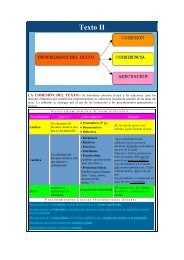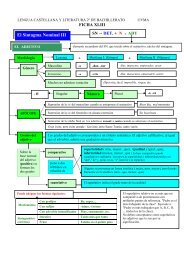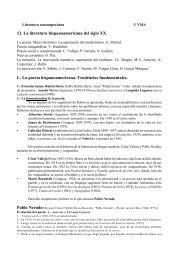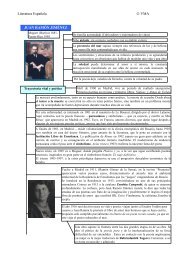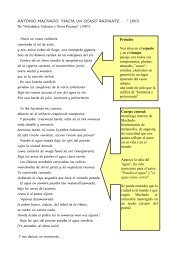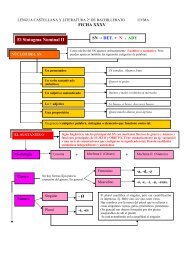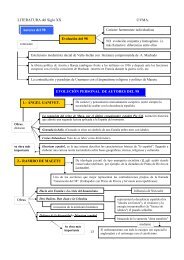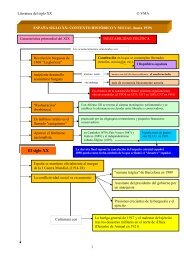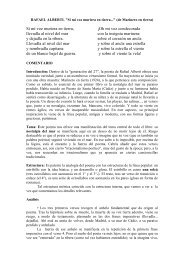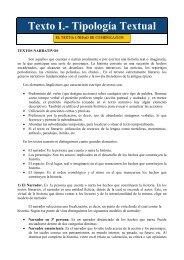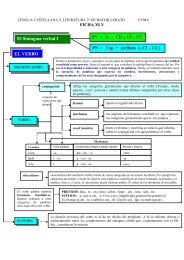La enseñanza de la sintaxis de la oración ... - Vicente Morales
La enseñanza de la sintaxis de la oración ... - Vicente Morales
La enseñanza de la sintaxis de la oración ... - Vicente Morales
You also want an ePaper? Increase the reach of your titles
YUMPU automatically turns print PDFs into web optimized ePapers that Google loves.
XXVIII Universidad <strong>de</strong> Otoño. Septiembre 2008<br />
Los nexos que encabezan estas proposiciones son el adverbio<br />
re<strong>la</strong>tivo don<strong>de</strong> o locuciones formadas por preposición + don<strong>de</strong>: adon<strong>de</strong>, <strong>de</strong><br />
don<strong>de</strong>, por don<strong>de</strong>, <strong>de</strong>s<strong>de</strong> don<strong>de</strong>, hasta don<strong>de</strong>, etc. 8 .<br />
Don<strong>de</strong> <strong>la</strong>s dan, <strong>la</strong>s toman.<br />
Suj: (ellos) o impersonal eventual.<br />
Pred: todo el enunciado (S.V.)<br />
Núcleo: toman (V)<br />
CD: <strong>la</strong>s (Pron. Pers.)<br />
CC: Don<strong>de</strong> <strong>la</strong>s dan (prop. sub. circuns.)<br />
Nexo: don<strong>de</strong> (adv)<br />
Suj: (ellos) o impersonal eventual.<br />
Pred: <strong>la</strong>s dan (S.V.)<br />
N: dan (V)<br />
CD: <strong>la</strong>s (pron. pers.).<br />
Estas proposiciones son conmutables por adverbios <strong>de</strong> lugar: *Aquí,<br />
allí, etc. +.<br />
4.1.3.3. Proposiciones subordinadas adverbiales <strong>de</strong> modo.<br />
Indican cómo se realiza lo expresado por <strong>la</strong> <strong>oración</strong> principal. Son<br />
por tanto complementos circunstanciales <strong>de</strong> modo, sustituibles por el<br />
adverbio <strong>de</strong> modo ASÍ.<br />
El nexo más frecuente es como, pero también pue<strong>de</strong>n funcionar<br />
como nexos los adverbios según y conforme y locuciones conjuntivas<br />
como: <strong>de</strong>l mismo modo que, igual que, tal cual, etc.<br />
Lo haré como dice el manual.<br />
Suj: (Yo)<br />
Pred: todo el enunciado (S.V.)<br />
N: haré (V)<br />
CD: lo (pron. pers.)<br />
CC: como dice el manual (Prop. sub. circuns.)<br />
Nexo: como (adverbio)<br />
Suj: el manual (S.N.)<br />
Pred: dice (V).<br />
A veces, el verbo <strong>de</strong> <strong>la</strong> proposición subordinada pue<strong>de</strong> estar elidido:<br />
8 Conviene distinguir <strong>la</strong>s proposiciones circunstanciales <strong>de</strong> lugar <strong>de</strong> <strong>la</strong>s<br />
proposiciones adjetivas introducidas por el adverbio re<strong>la</strong>tivo "don<strong>de</strong>". <strong>La</strong> diferencia<br />
estriba en lo siguiente: <strong>la</strong>s proposiciones adjetivas siempre llevan un antece<strong>de</strong>nte<br />
expreso: *Esta es <strong>la</strong> casa don<strong>de</strong> nací = Esta es <strong>la</strong> casa en <strong>la</strong> cual nací+.<br />
<strong>La</strong>s proposiciones circunstanciales no tienen antece<strong>de</strong>nte y están c<strong>la</strong>ramente<br />
vincu<strong>la</strong>das a un verbo: * iré don<strong>de</strong> me man<strong>de</strong>s+.<br />
<strong>Vicente</strong> <strong>Morales</strong> Ayllón Página 29



